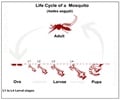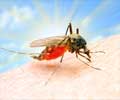
Dengue fever is a mosquito-transmitted viral infection that sickens 5 percent of the world's population each year and recently has begun to emerge in parts of the southeast United States. Building on a long-standing collaboration with Thai health officials and AFRIMS, Reich and his co-authors used the Bangkok dataset to characterize this important clinical and epidemiological feature, cross-protection. It means one's immune response to infection with one dengue strain offers some protection against future infection with others.
They report the first explicit quantitative evidence that short-term cross-protection exists since human experimental infection studies performed in the 1940s and 1950s by Albert Sabin. By extending existing methods for analyzing infectious disease time-series data, they have created and applied a new framework for estimating the duration and strength of cross-protection between multiple strains of an infectious disease, Reich points out.
"This dataset from Bangkok is unique," he says. "We don't know of any other data like this in the world. AFRIMS has been collecting this data, with strain-specific information on individual cases of dengue, for over 40 years. It provided us with a unique opportunity to analyze long-term disease patterns in ways that we are not able to do with datasets of shorter duration."
Epidemiologists know that many multi-strain diseases confer at least partial short-term cross-protection to people who come down with one. But cross-protection introduces "significant challenges" to researchers trying to create an accurate model of disease transmission or to evaluate vaccine effectiveness. Knowing how long cross-protection may last can help in planning well-controlled vaccine studies.
"Dengue is a unique and convenient disease for studying these dynamics of cross-protection," says Reich. "Many diseases either evolve too rapidly, like influenza, or have too many circulating subtypes, like malaria, for us to gain good traction on studying cross-protection. But dengue is sort of a 'goldilocks' virus in this way. It has four circulating strains, which means that it's in sort of a genetic diversity 'sweet spot.' There are not too many strains and not too few, which provides us with fertile ground for such study."
Advertisement
"We made head-to-head comparisons of models that included cross-protection and those that did not," Reich explains. "We essentially let different models compete with each other to explain the data best. And each model makes different hypotheses about how dengue works once it infects you. Consistently, when we look at models that are saying 'cross-protection exists,' they fit the data better than models that are saying 'cross-protection does not exist.' Also, these models are able to explain more of the variability that we see in the irregular size of annual epidemics in Thailand."
Advertisement
Source-Eurekalert














